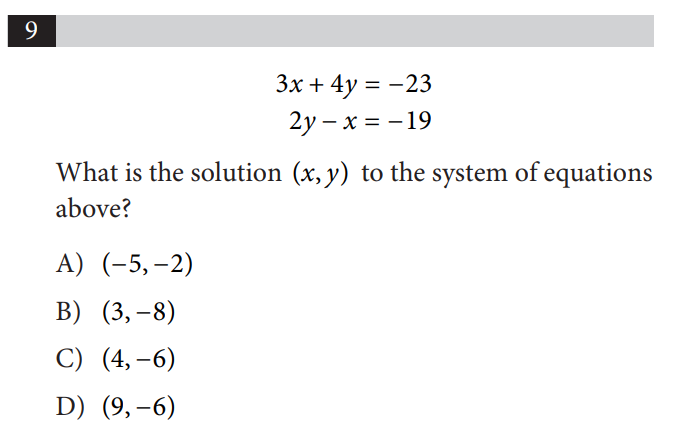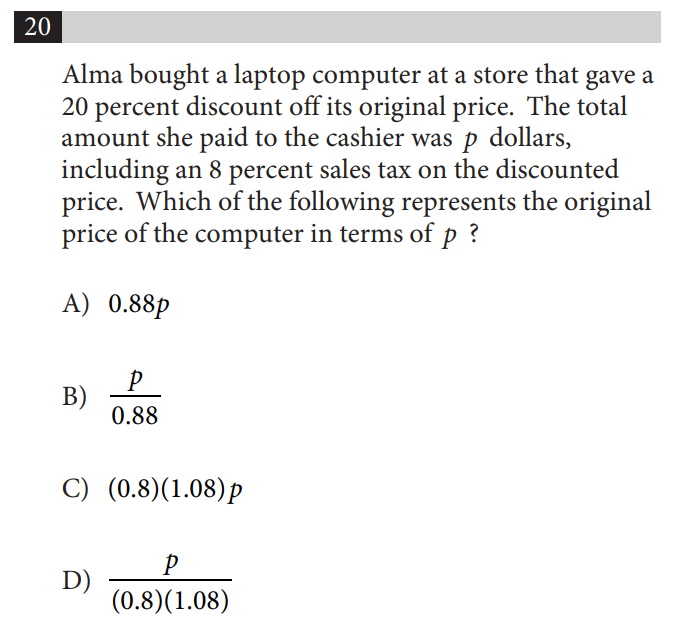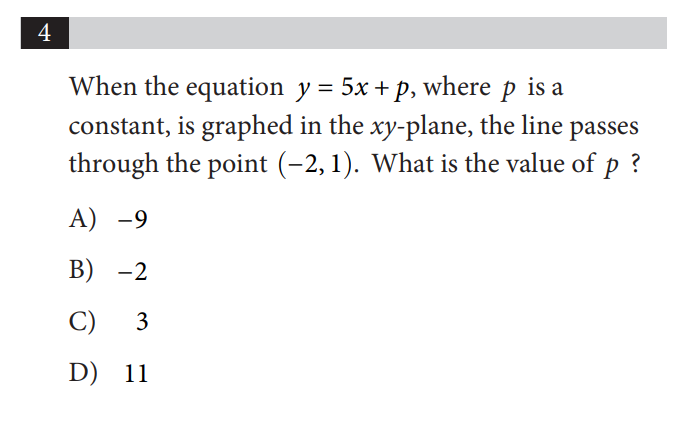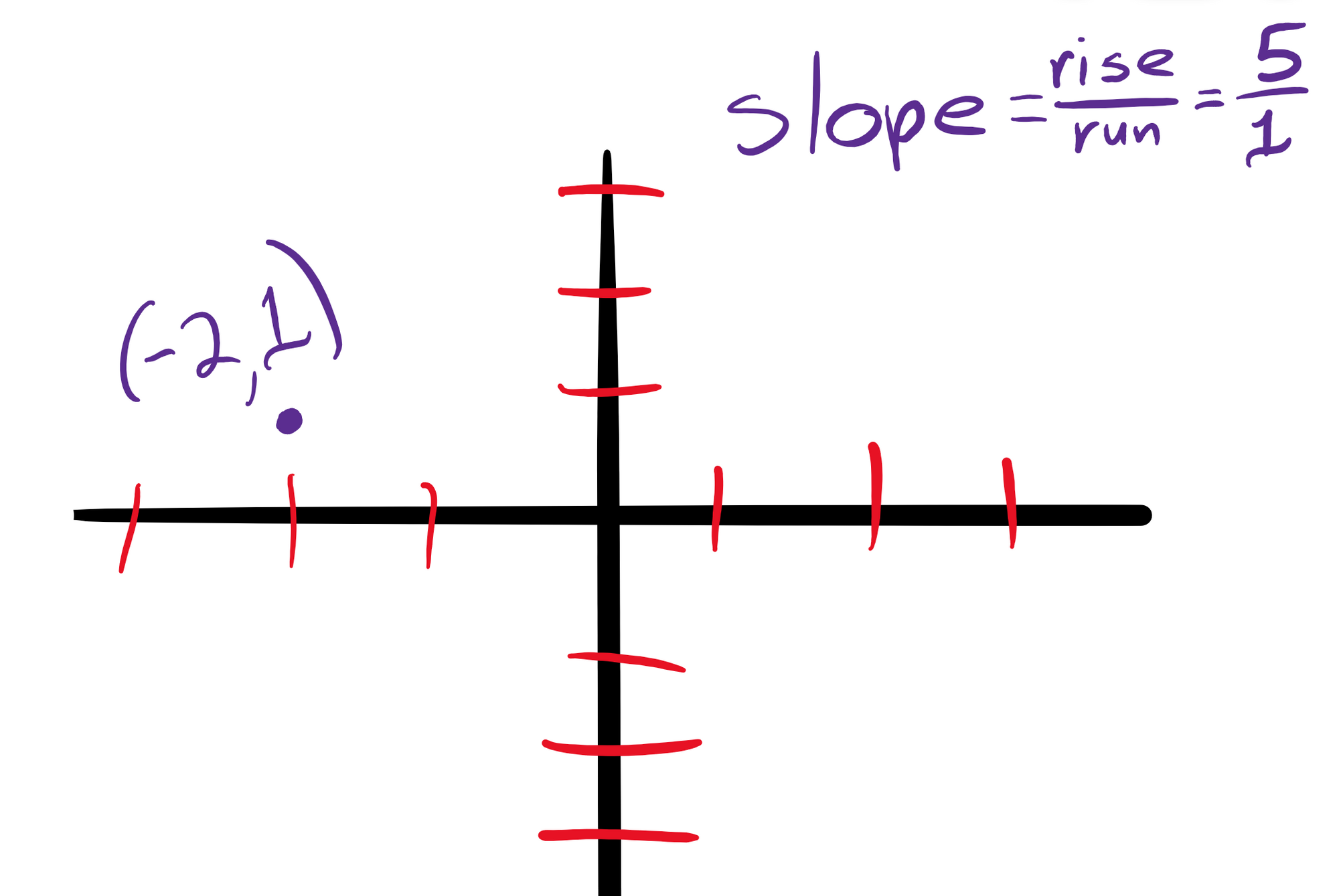🎓SAT
Fiveable SAT Math: Tips and Tricks
7 min read•Last Updated on July 11, 2024
Zaina Siddiqi
Debdutta Mandal
Zaina Siddiqi
Debdutta Mandal
📢 SAT Math: Tips and Tricks
The SAT Math test consists of 58 questions divided into two sections:
-
- ✍🏼 Section 3 of the SAT: 20 questions, non-calculator, in 25 minutes.
-
- 🧮 Section 4 of the SAT: 38 questions with a calculator in 55 minutes. The test will go by fast, so it's important to keep calm. We're going to give you some tips to keep in mind as you work on the math sections.
5️⃣ Major SAT Math Strategies
Here is a quick run-down of the 5 major strategies we'll be discussing:
-
- 🔚 The End: Make sure to answer what the question is asking.
-
- 🔌The Plug: Substitute real numbers for the variables and check against the answer choices.
-
- ⬇️ Break it Down: Piece together the problem from solvable pieces instead of all at once.
-
- 👉👈 Close Enough: Eliminate answers that are wayy too big or small; find the medium.
-
- 📲 Calculate: Only use your calculator when you need it for complex equations with big numbers. Now, let's go through these one-by-one with practice questions 👟
🧰 SAT Math Strategy Toolbox
🔚 The End
** To use The End, all you have to do is finish reading the question before you start working on it.**
This strategy makes you slow down to make sure that you are actually solving the question that you are supposed to be answering. It might seem like common sense, but using this one tip can actually help you increase your score and stop making simple mistakes 😢
WOW. This might not seem revolutionary, but everyone has made this mistake before by rushing and starting to solve the problem before you even get to the "?". Look at the example below for ideas on how this strategy might help.

You got an answer of 0.5, which is the correct answer for x, so why did you get it wrong? You didn't use 🔚 The End! So let's go back to the question, and try using the strategy.
The question asked you for the answer to 2x+1, not just x 😭. If you read the question before you started working the problem, you would have seen that the correct answer would be x=2 and not x=0.5.
Make sure to use 🔚 The End so that you don't miss any more easy-level questions because of reading errors!
🔌 The Plug
This strategy has 2 applications for you, as it is one of the most versatile strategies for the math section. Make sure to keep this one handy. Let's differentiate between the 2 applications by calling them The OG Plug and The Plug 5.0.
The OG Plug
** To use The OG Plug, all you have to do is pick some easy numbers to work with and plug them in for your variables in the question, then check that against the answers!**
This strategy can help you solve almost any problem in this section involving variables and especially problems with more than 1 use of a variable! Let's look at a practice problem together to look at this strategy in action:

If you try to solve this problem with your Algebra 2 knowledge, it can get really complicated with fractions and double variables 😳
-
- However, 🔌The OG Plug can make this problem super simple for most people! Since the problem says that x > 3, then we just need to pick a value for X greater than 3 to plug in.
-
- So, let's pick 4 for x!
-
- When we use 🔌The OG Plug with x=4, then we get 42/13.
-
- Now, all we have to do is plug in our number for x in all of the answer choices and see what matches the problem. 👍
- Now, all we have to do is plug in our number for x in all of the answer choices and see what matches the problem. 👍
Answer B solves for 42/13 which is equal to our solution to the original problem.️
If you used algebra and added the fractions with the FOIL method and too many other steps, then you should reach the same conclusion!
The Plug 5.0
To use The Plug 5.0, all you have to do is plug the numbers from the answers into the question and see which yields the right result!

If you try solving this system with elimination or substitution, you will end up with some really big numbers, or it will take a long time with lots of algebra! But using 🔌The Plug 5.0, the answers can tell us which one is correct 🎊 !!
We just need to plug in the ordered pairs for X and Y for each answer choice and check which pair solves both equations! Let's start with letter B in the second equation. Now we get that:
That equation is true! Since we picked an awesome ✨ answer choice to start with, let's just double-check the first equation before marking the correct answer
When we plug in (3,-8) to the first equation, we get that:
which is also true 🎉!! That means that Answer Choice B is correct. Let's mark that and move on without using any algebra, saving us lots of time! 😎
⬇️ Break it Down
This strategy helps you break up complex questions in the SAT Math section. Break it Down 💔 can help you answer questions that have too many variables or have tons of fractions by solving parts of an equation to put them back together.
** To use Break it Down, pick steps to break up different parts of the equation, solve them independently, then put all the pieces back together!**
This strategy can help you solve almost any problem in this section involving:
-
- Multiple variables
-
- Fractions
-
- Percentages
-
- Ratios Let's look at a practice problem together to look at this strategy in action:

When you read this question, it might be nice to use the Rephrase Global Strategy 🌍, but you can solve it just as easily with ⬇️ Break it Down. So, the first thing that we need to do is define the variables and the percentages.
🧠 We know that:
-
- p = new price
-
- there was a 20% discount on p
-
- there was an 8% sales tax applied Those 3 pieces of knowledge (plus defining variable o = original price) are how we are going to ⬇️ Break it Down 😎.
-
- Our first step is that 20% off means that we will be subtracting from the original price.
-
- We now know that p=0.8* o!
-
- We also know that there is a sales tax of 8% so that would be adding to price. So, we know that p = 1.08 * 0.8 * o!
-
- Now all we need to do is take the equation and put it in terms of p.
-
- So if we divide both sides by (1.08 * 0.8),
-
- Then we get that Dp/(0.81.08) is the correct answer 🙋 Time to mark that and move on.
👉👈 Close Enough
This strategy is a huge time-saver when you are taking your SAT Math. Close Enough can help you eliminate answers and easily see the correct one 👍
** To use Close Enough, try to use common sense to see which answers are way too big or small, then find a realistic answer. Look at the answers before solving!**
This strategy can help you solve almost any problem in this section involving difficult concepts and is especially useful for multi-step problems. Let's look at a practice problem together:

When you start this problem the BIGGEST TIP 💡(besides 👉👈 Close Enough) is to 🎨 Sketch it Out! Whenever you have a problem that involves an equation with an ordered pair (or a graph without one given), you should 🎨 Sketch it Out! on a hand-drawn graph!

🎨 Sketch it Out : Self-Created; This graph shows you that you drawing don't have to be perfect to get the idea!
To use 👉👈 Close Enough, we just need to analyze our sketch and find the direction of the slope. The line has a positive slope, meaning that the line will increase in Y and X, or decrease in Y and X. With that knowledge, we know that our Y-intercept will be higher than the current Y value of our point.
We can immediately Eliminate 🧐 A and B, since those points too low. Since the slope is 5/1, that means that the slope has a larger "rise" (in Y) than "run" (in X)! That means that our Y-intercept will be D. 11, since it is the highest value possible. Now we get to mark that and move on!
📲 Calculate
This is less of a strategy and more of an overall tip for the SAT Math Calculator (Section 4) 💡
While you are allowed to use your calculator for all of section 4, one of the biggest issues is knowing when to use your calculator and when not to! While when to use a calculator is slightly a personal decision, we have a general rule of thumb for recognizing when it's needed:
** To choose when to Calculate, you need to read the problem and decide whether there is a calculator function to solve the whole question. Also, you can Calculate to do simple arithmetic always to avoid simple mistakes!**
There is no practice problem to review this strategy so just use this strategy when you need it. When you see $1463 times 17 on your SAT, you probably need a calculator, but some people might not so learn your own strengths and weaknesses before your SAT!
💫 Closing
As you embark on your SAT Math journey, remember these five major strategies that'll save time and prevent mistakes. You got this, now is your time to shine! Believe in yourself. Best of luck on your SAT Math journey! You've got this! 💫